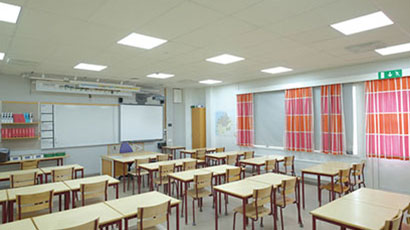-

How can light help me concentrate?
Lighting in Education
-

Higher illuminations levels and higher CCT leads to increased concentration
-

Optimised lighting can have positive effects on performance, social behaviour and also on physical health and well-being

Lighting with higher illumination levels and higher colour temperature shows positive effects on the level of concentration and/or oral reading fluency (ORF)
Read more...
Lighting with higher illumination levels and higher colour temperature shows positive effects on the level of concentration and/or oral reading fluency (ORF).
The intervention in the experimental groups took place during all focus tasks where the pupil had to read something. Children in the experimental group, with the optimized lighting, started with a lower score (assessed before the intervention) and ended with a significant higher score (assessed after the intervention) in ORF compared to the children within the control group. The assessment itself took place under standard lighting for all children. Furthermore, the motivation was evaluated. Even though, there have been no significant findings for motivation, there is a positive upwards trend for motivation under the optimized lighting, while the trend for motivation under standard lighting declined during the school year.
Conclusion: Higher illuminations levels and higher CCT leads to improved oral reading fluency.
Long term effects of light on concentration and inaccuracy.
The study design consisted of a pre/post measurement with an intervention phase in-between the measurements with standard or blue enriched lighting. Speed of cognitive processing, concentration performance, and inaccuracy has been measured. Pre-test took place for all groups under standard lighting. Post-test was under standard or acute blue enriched lighting respectively for the intervention phase with standard or blue enriched lighting period.. With respect to concentration and performance, acute blue enriched lighting after long-term standard lighting and also long-term blue enriched lighting and standard and acute blue enriched lighting showed significant differences compared to standard lighting. For inaccuracy, long-term blue enriched lightings showed significant differences compared to standard lighting. Memory effects have not been measured, but it has to be assumed that due to higher concentration levels there might be a positive effect on memory. Nevertheless, this study has shown that there are already beneficial long-term effects due to improved lighting solutions.
Conclusion: Blue enriched light during classes can improve speed, performance and concentration.

In educational environments, optimised lighting can have positive effects on performance, social behaviour and also on physical health and well-being
Read more...
In educational environments, optimised lighting can have positive effects on performance, social behaviour and also on physical health and well-being.
In a summary of three Dutch studies, the findings about the effect of light demonstrate beneficial effects of optimized light settings in educational environment. All three studies used the same light system for their experimental groups, which consisted of 1,000lx illuminance level and 6,500K (cold white) colour temperature. For the study controls, there had been (1) 600lx and 4,000K, (2) 380lx and 3,000K, and (3) 300lx and 3,000K to 4,000K. In total 197 (98, 44, and 55) pupil participated in these studies. While the second and third study report better performance in concentration or at least a positive trend for concentration and fewer errors compared to their controls, findings of the first study report a better performance in concentration test of the control group. Nevertheless, the first study also reports an increased performance growth in the experimental group compared to the control group.
Conclusion: Higher illuminations levels and higher CCT leads to increased concentration.

Insufficient blue light in the morning results in late bedtimes and delays the body clock thus contributing to health and performance problems
Read more...
Insufficient blue light in the morning results in late bedtimes and delays the body clock thus contributing to health and performance problems.
A significant delay in DLMO of about 30 minutes occurred in the participants after wearing the orange glasses that indicates that a lack of short-wavelength light may lead to a change in circadian rhythmicity. These findings correlate with other findings from laboratory settings. A delayed circadian clock (eveningness) can lead to disadvantages in exams and poorer academic performance. A study with 132 university students graded from 20 to 22 years, showed a highly significant positive correlation between early chronotype and better grades. Even further, recent studies showed that a delayed circadian clock (eveningness) could be a risk factor for mental health (higher possibility of depression) and physical health or health-impairing behaviours.
Conclusion: Lack of bright and blue-rich light in the morning delays the body clock and makes us go to bed too late.



